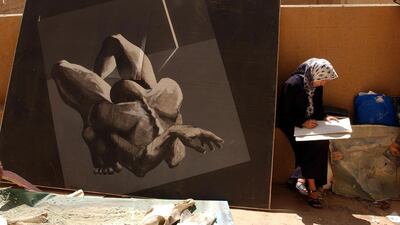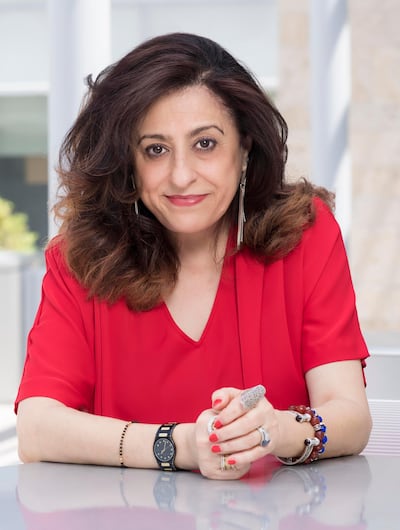“Archives are the voices of the past,” says Baghdad-raised art historian Nada Shabout. More than 15 years after she began tracking the dispersal of looted paintings from the Iraqi Museum of Modern Art, Shabout says that archives and documentation are still an overriding challenge in the nascent field of Arab art scholarship.
"Archives tell us different stories about how things were," Shabout tells The National from her US home near the University of North Texas, where she is a professor. "It forces us to look at the smaller stories that are part of the richness of culture. For Modern Art, there is now the fear of losing Modernist artists, who are sadly leaving us because of age, and taking their memories with them."
On a most basic level, archives help establish what happened, when. For Arab art history, the problems facing a precise or exhaustive chronicle are double: existing archives are often incomplete, damaged or inaccessible, because of conflict in the region. And the analysis made by canonical art history of what was happening in the Middle East and Turkey – written primarily by US academics – views art of the region through the prism of its engagement with western art.
"When I came on the scene as a graduate student in the 1990s, there were very few resources. Wijdan Ali Al-Hashimi's Modern Islamic Art: Development and Continuity [1997] was the first available text, along with few essays," says Shabout. "There was a meta-narrative to explain the history of Modernism in the Arab world: there was a rupture in the late 19th century, then came colonialism, and the Arabs learnt Modern art that way. They imitated the West and they kept trying, struggling to find their own way. That is so simplistic.
“I built on it by talking to the artists and looking at things in a different way,” she continues. “We start by looking at archives – finding what artists thought and wrote about. For example, it’s not that [Iraqi artist] Jewad Selim just went to Paris and copied European aesthetics, as some have argued. When you actually read what Selim said, he and his contemporaries were negotiating their heritage and their understanding of Modernism. Instead, perhaps you need to think, I may need to reevaluate how I see Picasso.”
When Shabout first started her archive project, the need to document Iraqi art was pressing. Baghdad had been a site of the Arab artistic flowering of the 1950s and '60s, with artists such as Selim (who made the famous Freedom Monument in Tahrir Square), Shakir Hassan Al Said and Kadhim Haydar. Most of these works had been collected in the Iraqi Museum of Modern Art, formerly known as the Markaz Saddam lil Funun – which was looted in the days after the US invasion of Baghdad in April 2003.
About 8,000 works went missing. The response among Iraqi artists was immediate: they formed a coalition to relocate the works and buy them back. At the time, most were still in Iraq, and the artists were able to find some of the missing works sold in the open – including a painting by Spanish artist Joan Miro and Selim's Motherhood statue, bought back for $200 (Dh735), in the flea market.
In one incident, which Shabout mentioned during a talk given in the Online Cultural Majlis run by Sultan Al Qassemi, she was sent an image of two truckloads of paintings, stacked against each other in the open beds of the vehicles. They could have been hers for $5,000 in cash – “but I didn’t have it”, she says. In the end, the important and renowned works were smuggled out of the country and sold on the international black market. The vast majority of the rest is still unaccounted for.
While the artists were tracing the artworks, Shabout was also chasing their images to assemble a digital archive of the former contents of the museum, supported by funding from the Iraqi American Academic Research Institute in Iraq. Because no comprehensive record had been kept, Shabout had to rebuild the lost collection from existing literature. She bought 500 hard-copy pictures from the photographer of the museum, scanned them, and cross-referenced them with whatever print documentation she could find – museum brochures, reviews from Lebanese magazines and exhibition catalogues.
The project later became part of the Modern Art Iraq Archive (Maia), which Shabout launched as an open-source platform in 2011, in collaboration with Sarah Whitcher Kansa of the Alexandria Archive Institute and researcher Saleem Al-Bahloly.
“For me, the urgency in relation to Iraqi art is the fact that there is an erasure of memory that’s taking place,” she says. “It’s not just an issue of writing the history or having more access to research, but the reality is that the history of Iraq is being lost.”
Maia has grown over the years, both through Shabout’s additions – Facebook, she says, is a great tool – and from those of her graduate students and others working in the field. But the site only covers one country. The need for proper archival material differs internationally, from Egypt, where there was a robust public record in the early 20th century, to places such as Libya and Yemen, where the dearth of archives has been compounded by years of conflict.
A second, equally important challenge, is that of access. Where does a young scholar, interested in the field of Arab art, begin to conduct research?
One place is close to home: New York University Abu Dhabi has become a leader in the field of digitising archives, to make resources available to its faculty members and because it has the advantage of being set up in the digital age. The university runs a number of digitisation projects, such as the Akkasah archive, of around 33,000 photographs from the Middle East and North Africa that exist in both hard copy as well as digital scans; the Library of Arabic Literature, which has put a significant collection of Arabic books online for download, often with first-time translations; and the Arabic Collections Online, which scans hard-copy works of Arabic literature in the public domain to make them freely available digitally.
It is also working to establish a dedicated collection for the study of Arab art, and Salwa Mikdadi, a Palestinian-Kuwaiti art historian who teaches at NYUAD, says they are now focusing on acquiring books on West Asia and North Africa, particularly those published prior to the 1990s.
Mikdadi herself has accumulated an exceptional archive on Modern Arab art. She was one of the first to work in the field and has personal interviews with major artists, many of whom have now died. She donated this archive to NYUAD in 2016, where it exists now on the library shelves – and is in the process of being digitised – as the Salwa Mikdadi Papers.
“An archive,” Shabout says, “is only as important as the access to it.”



